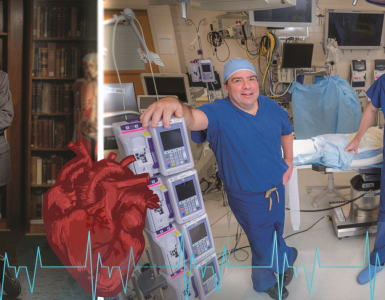Antiretroviral cocktails can make human immunodeficiency virus, or HIV, undetectable and untransmittable, but both the virus and its treatment can also accelerate aging of bone and muscle.
Now Medical College of Georgia scientists are looking at drugs already being studied in clinical trials for cancer to help put the brakes on these classic indicators of aging that can lead to falls, fractures and early frailty.
“These drugs are doing what they are supposed to be doing: They are extending lifespan. Now what we need to do is deal with the side effects so you can extend healthspan as well as lifespan,” says Meghan McGee-Lawrence, PhD, biomedical engineer in MCG Department of Cellular Biology and Anatomy at Augusta University.
“They call it ‘accentuated’ aging,” says Mark Hamrick, PhD, bone and muscle biologist and co-director of the MCG Center for Healthy Aging. “Bone and muscle changes you normally see in a 75-year-old person start to show up in a 65-year old,” he says as he looks at graphs of walking gait and speed and how they decline with age.
Hamrick and McGee-Lawrence are co-principal investigators on a $3.2 million grant from the National Institute of Arthritis and Musculoskeletal and Skin Diseases to identify logical points to put the brakes on the unhealthy acceleration and determine whether drugs already in hand are the ticket.
In normal aging and with the accelerated circumstances with HIV and its treatment, the damage plays out like this: Tryptophan is an essential amino acid, which is important to metabolism. Indoleamine 2,3-dioxygenase 1, is a natural enzyme that helps break tryptophan down into usable products like kynurenine, which is important for the production of fuel for our cells. With age, levels of tryptophan tend to decrease while IDO1 levels increase.
One result is more of the available tryptophan tends to get converted to kynurenine, which is known to activate the aryl hydrocarbon receptor, or AhR.
AhR normally has a pretty global role, helping sense what is happening in the environment of the body and making the proper adjustments, including to the immune response and gene expression. It also has important roles like glucose regulation and toxin removal, both of which help prevent disease.
This receptor already is highly expressed in bone and muscle cells and is considered to have a key role in aging and lifespan, the scientists say.
But with aging, and even more so with HIV and its treatment, come too much of what was a good thing.
Higher AhR expression is associated with stiff, aging blood vessels in mice and humans. Higher kynurenine produces higher levels of destructive oxidative stress, which damages cell powerhouses so our cells don’t get all the energy they need, increases inflammation and generally ages our bone and muscle.
MCG aging experts Hamrick and McGee-Lawrence, along with Carlos Isales, MD, chief of the MCG Division of Endocrinology, Diabetes and Metabolism and codirector of the Center for Healthy Aging and aging researcher Sadanand Fulzele, PhD, are the first to find and explore how these essential systems turn against our aging bone and muscle. Work by others in cancer first connected kynurenine to AhR and the potentially bad consequences.
Most recently, the MCG scientists have found these aging-related dynamics can increase oxidative stress and induce senescence in bone marrow stem cells, which produce bone and muscle cells. With senescence, basically cells don’t typically die they just cease to function optimally or their function may change, and they can start secreting a lot of inflammatory factors. Problems with oxidative stress and senescence likely both result from the antiretroviral drugs impacting cell powerhouses, or mitochondria, so they don’t operate as an efficient normal.
Hamrick says a bottom line is it all basically accelerates aging by about a decade, noting that other aspects of aging, like cognitive decline, appear impacted as well.
“We have seen that you get some increased markers of senescence and oxidative stress specifically in muscle and bone cells,” Hamrick says. And, despite the clear efficacy of today’s antiretrovirals against
HIV, there is still a basal level of inflammation in patients that appears to be increasing kynurenine levels, Hamrick says.
He and McGee-Lawrence want to intervene in the compounding process that produces a recipe for a weaker body. They have evidence that, for example, markers of muscle atrophy, bone loss and AhR activation all are increased in their mouse model of HIV infection. Conversely, they have early evidence that either knocking out AhR or inhibiting it with drugs increases muscle and bone health/strength in their model.
Their new studies also are further testing their key hypothesis that excessive AhR activation is key to the bone and muscle loss that come with aging and to the accelerated problems with HIV infection and treatment. They are using AhR knockouts both in bone and in muscle to learn more about what the receptor is doing.










